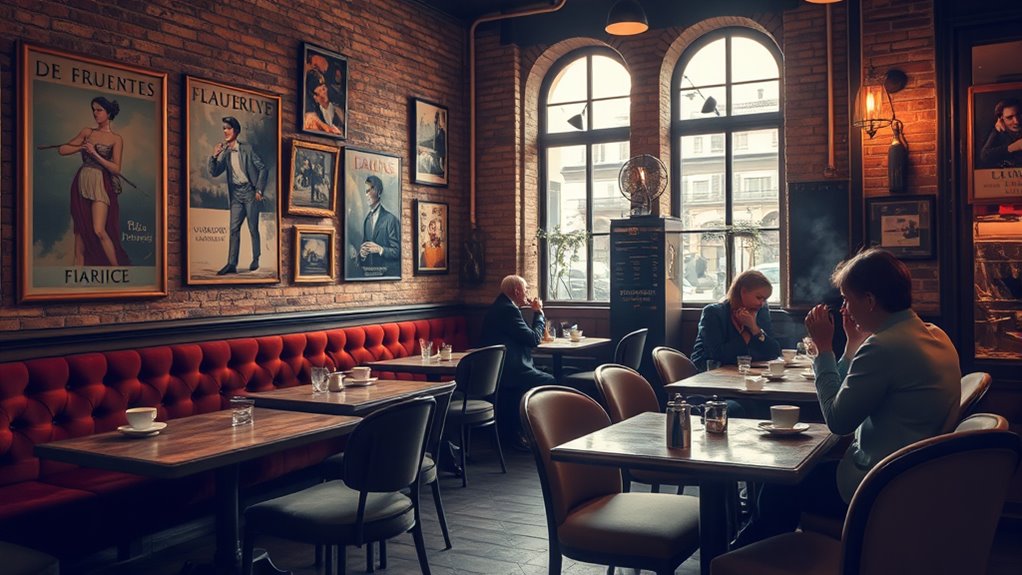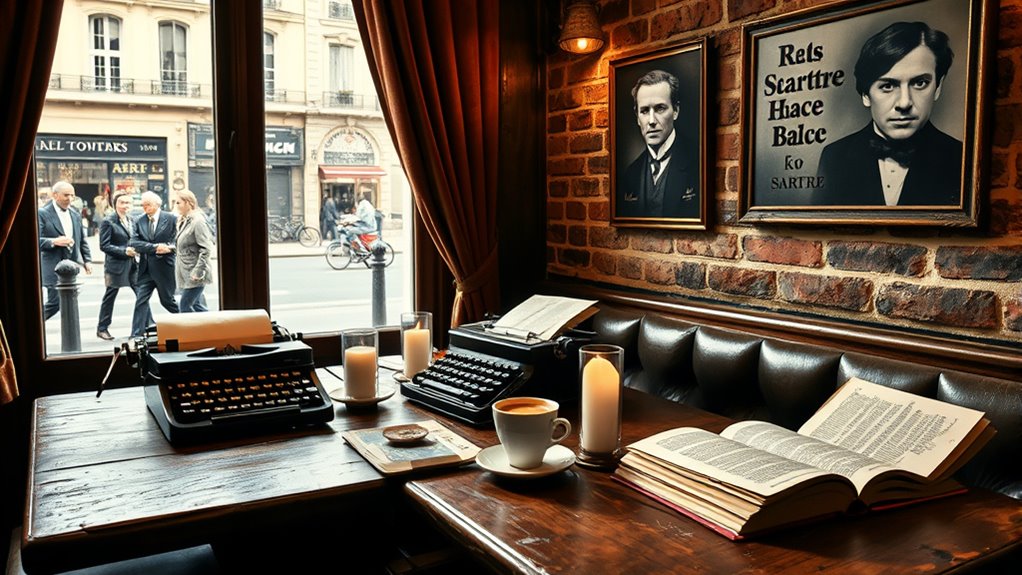Cafés in French literature serve as vibrant spaces where ideas, society, and culture collide, from Balzac’s detailed social microcosms to Sartre’s existential debates. They embody more than just venues for coffee—they’re symbols of intellectual exchange, rebellion, and community shaping literary movements and societal shifts. These cafés reflect the changing rhythms of Parisian life and ideas. Keep exploring to uncover how these spaces influenced France’s literary and philosophical landscape across centuries.
Key Takeaways
- Cafés in French literature serve as vibrant social spaces reflecting Parisian life from Balzac to Sartre.
- Balzac depicted cafés as incubators of literary ideas and societal interaction in 19th-century France.
- Literary cafés evolved into symbols of philosophical inquiry, notably for existentialists like Sartre and Camus.
- These spaces symbolize intellectual debate, social change, and community building across French literary history.
- Cafés continue to represent the dynamic cultural and philosophical spirit influencing French literature.

Throughout French literature, cafés serve as vibrant settings where characters converge, ideas flourish, and societal shifts unfold. These spaces go beyond simple venues for coffee; they embody café symbolism, representing intellectual hubs, social battlegrounds, and sites of personal revelation. Literary cafés, in particular, have become iconic, shaping narratives and character development across generations. As you explore the evolution of French literary culture, you’ll notice how these establishments reflect broader societal themes, offering a lens into the changing landscape of French thought and identity. café symbolism encapsulates much of their significance, serving as a mirror to societal transformations and intellectual currents.
In the 19th century, writers like Balzac utilized cafés as microcosms of Parisian life, where the flow of conversation and the clink of cups mirror the bustling energy of the city itself. These cafés are more than just backdrops—they symbolize the social fabric of the time, blending class distinctions, political debates, and artistic ambitions. Balzac’s detailed descriptions of these spaces reveal their significance as places where literary ideas incubated and where writers gathered to exchange inspiration. You can see how literary cafés serve as fertile ground for creative exchange, fostering a sense of community among writers, journalists, and thinkers.
Moving into the 20th century, the role of cafés in French literature deepens as symbols of philosophical inquiry and existential reflection. Sartre and Camus frequented these establishments, turning them into arenas for debate and introspection. The café becomes a stage where ideas about freedom, morality, and human existence are challenged and refined. Sartre’s own writings often depict these social spaces as crucibles for intellectual rebellion—symbolizing a break from tradition and a pursuit of individual authenticity. In this way, literary cafés embody the spirit of existentialism, serving as both physical spaces and metaphors for personal and philosophical exploration.
As you follow the trajectory from Balzac to Sartre, you’ll see how these venues evolve from bustling social hubs to symbols of revolutionary thought. Literary cafés are not static but dynamic symbols that mirror the shifting currents of French culture. They stand as proof of the importance of dialogue—whether it’s about societal change, artistic innovation, or personal identity. In substance, these cafés become more than just places to drink coffee; they are emblematic of the enduring power of conversation, reflection, and community in French literary history. By understanding their symbolism, you gain insight into how French writers have long used these spaces to challenge, inspire, and shape their society.
Frequently Asked Questions
How Did Cafés Influence French Literary Movements Historically?
Cafés have shaped French literary movements by serving as vibrant social hubs where writers gather, share ideas, and inspire each other. You’ll notice how these spaces became symbols of intellectual freedom and creativity, fostering literary symbolism that reflects society’s complexities. By turning cafés into collaborative environments, authors like Balzac and Sartre influenced movements such as realism and existentialism, making these venues essential to France’s literary evolution.
You’ll find authors like Balzac, Zola, and Sartre frequently depicted cafés in their works. They used café symbolism to represent social interactions, intellectual exchanges, and the vibrancy of literary gatherings. By illustrating these lively spaces, they highlight how cafés serve as hubs for creativity, dialogue, and cultural movements. Their vivid descriptions invite you to see cafés not just as settings but as essential catalysts in shaping French literary history.
Are Specific Cafés Associated With Particular Literary Figures?
You’ll find that specific cafés are deeply linked to literary landmarks and symbolize key moments in French literary history. For example, Les Deux Magots and Café de Flore in Paris symbolize intellectual hubs for Sartre and Camus, while Café de la Paix connects to Balzac’s vivid descriptions. These cafés serve as focal points, embodying café symbolism that captures the spirit of the writers’ lives and works.
How Have French Cafés Evolved From Balzac to Sartre?
You see that French cafés have evolved from Balzac’s time to Sartre by shifting from exclusive literary salons to more inclusive café culture. In Balzac’s era, cafés served as refined spaces for intellectual exchange, while Sartre’s time saw cafés becoming vibrant hubs for existentialist debates and political activism. This transformation reflects broader changes in French society, where cafés remain essential spaces for dialogue, creativity, and cultural evolution.
What Role Do Cafés Play in Contemporary French Literature?
In contemporary French literature, cafés symbolize more than just social spaces—they embody urban socialization, creative inspiration, and cultural identity. Writers use cafés as literary symbolism to explore themes of connection, anonymity, and modern life. You see characters meet, reflect, and transform within these vibrant settings, making cafés a dynamic backdrop that captures the evolving social fabric of France. They continue to serve as powerful symbols of community and personal discovery.
Conclusion
As you reflect on the café’s role from Balzac to Sartre, you realize it’s more than just a backdrop—it’s the heartbeat of French literature. This small space holds the power to ignite passions, spark revolutions, and shape minds beyond measure. Truly, the café’s influence is so vast, it could fill an entire universe, echoing through centuries of thought. You can’t deny: without these cafés, French literature would be an empty canvas.








